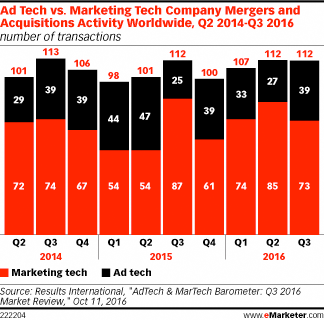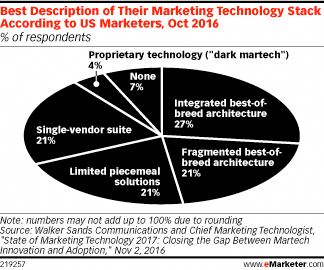It’s Getting Harder to Make Marketing Tech Decisions
April 27, 2017
![]() The fluidity of the marketing technology space is making it harder than ever for marketers to choose between standalone best-of-breed tech providers and multisolution suites.
The fluidity of the marketing technology space is making it harder than ever for marketers to choose between standalone best-of-breed tech providers and multisolution suites.
On the one hand there’s consolidation, which improves integration and aims to get marketers closer to an all-in-one, full-stack solution. But on the other hand, there’s a boom in ad tech and marketing tech startups that aim to offer marketers best-of-breed tools that are more specialized but tougher to integrate.
 “Facing both challenges, marketers have a great deal of uncertainty on their hands,” said eMarketer principal analyst Lauren Fisher.
“Facing both challenges, marketers have a great deal of uncertainty on their hands,” said eMarketer principal analyst Lauren Fisher.
A Results International report found there were 232 marketing tech company mergers worldwide in the first three quarters of 2016, up from 195 in the same period a year earlier.
Ad Tech vs. Marketing Tech Company Mergers and Acquisitions Activity Worldwide, Q2 2014-Q3 2016 (number of transactions)
According to a March 2017 report from Hampleton Partners and 451 Research, some 805 marketing application providers in the US and UK made acquisitions in the past 30 months, and 122 of them made more than one. In mid-April, Oracle made waves in the industry by signing a deal to buy ad measurement and verification company Moat.
The acquisitions point to a concerted effort to consolidate the space, which could start to relieve the integration challenge that marketers face when working with standalone pieces of technology. “Consolidated solutions tend to be more integrated by nature,” said Rob Griffin, chief innovation officer at digital agency Almighty. “Vendors do make an effort to integrate the pieces they buy.” But even then, consolidation is not necessarily what marketers need.
 Despite all of the integration advantages that come with the merging of various platforms and companies, a significant portion of marketers still prefer standalone, best-of-breed solutions. According to October 2016 research from Walker Sands Communications and Chief Marketing Technologist, nearly half of US marketers reported using best-of-breed architecture, even if it was fragmented, vs. just 21% who said they use a single-vendor suite.
Despite all of the integration advantages that come with the merging of various platforms and companies, a significant portion of marketers still prefer standalone, best-of-breed solutions. According to October 2016 research from Walker Sands Communications and Chief Marketing Technologist, nearly half of US marketers reported using best-of-breed architecture, even if it was fragmented, vs. just 21% who said they use a single-vendor suite.
However, as best-of-breed solutions get gobbled up by vendors aiming to offer full-stack suites like Adobe, Salesforce or Oracle, it becomes harder to work with them.
The operational inefficiency of working with a company after it’s acquired is just part of the problem, according to Griffin, and feeling pressure to switch to a multisolution suite is another. “The day after Oracle announced its acquisition of Moat, I was on the phone with clients all day,” said Griffin. “They were asking, ‘Should I keep Moat if I don’t want to bundle my stack?’” In other words, integration and consolidation come at a price: flexibility.
The choice between best-of-breed vs. full-suite solutions will only get harder as the marketing technology landscape continues to expand. According to Scott Brinker, editor of the Chief Marketing Technologist and chief technology officer for ion interactive, the marketing tech landscape had 3,874 players last year, and will have even more this year.
“Startups are popping up every day,” he said. Yet no matter how specialized or effective standalone solutions might be, their siloed architecture may be a concern that marketers will eventually no longer be able to overlook.
Marketing technology is an “imperfect market” and behaves unlike any other technology space, Brinker said. Consumer technology—smartphones, wearables, cars, internet of things (IoT) devices and TVs—is evolving quickly, and marketers’ need to reach consumers across all these channels (established and emerging) is what drives acquisitions, mergers, startups and other activity in marketing technology.
“This will be the state of things for the next several years,” Brinker said. “Unless consumer technology slows down, which it likely won’t, we won’t see marketing technology behaving predictably.”
For marketers, that means tough decisions lie ahead as they choose either giving up their preference for best-of-breed tools in favor of consolidated and perhaps better integrated solutions, or sticking with more specialized technology where some integration challenges will inevitably persist.
Courtesy of eMarketer






























